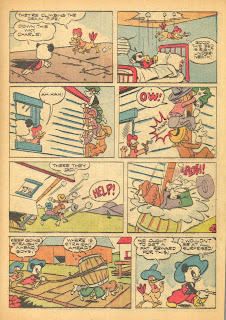John Stanley claimed two Bugs Bunny comic books as his first work for Western Publications. This baffles me, as the two comics in question (Four Colors 33 and 51) are clearly the work of the West Coast division, with Californian artists such as Tom McKimson having done the final artwork. Plus, they're distinctly inferior to even the earliest work of John Stanley--a general trend of the West Coast material of this era, Carl Barks aside.
Why Stanley included these false credits in his q.v. beats me. Thus, his first long comics narrative is the Western burlesque "The Ghostrider--" subject of today's post. First, here's the bondage-is-fun cover:
In the spirit of Carl Barks' first few long narratives ("The Mummy's Ring" and "Porky of the Mounties" in particular), this is less of a bona-fide adventure and more of a broad genre take-off. Barks' stories, even at their most burlesque, still come off as more grave than Stanley's--at least, until Stanley's early dark masterwork "The Secret Six," which can be read HERE.
As first efforts go, "The Ghostrider" is not bad. It flails about harmlessly, with the occasional investiture of wit and narrative skill. (The more playful second story in this issue, "The Magic Hat," can be found HERE.)


































"The Ghostrider" lacks the narrative polish and stakes-building that would typify John Stanley's work by the late 1940s. Top-heavy with licensed supporting characters (Andy's goil Miranda, and Woody Woodpecker's nemesis Wally Walrus), the story burns through many pages without achieving much.
When the stakes-raising, more straight adventure material kicks in, later in the story, Stanley's telling becomes more efficient. Action sequences peppered with strong gags manage to hold the reader's interest.
Most compelling are the group of hotel "porch loafers" who decide to give chicken and panda an old-school Western shoot-em-up, more out of general boredom than of score-settling. This meta-story (within a story) seems to dismiss the Western adventure genre as a quaint thing, at best. While this is a stand-out sequence in a fair-to-middlin' story, it serves to make the actual no-kidding action sequences rather perfunctory.
Said sequence is punctuated with welcome humor, and includes one of Stanley's earliest double-whammies of "CHOFF" and "CHOMPF." Other early Stanleyisms such as un-punctuated speech balloons, sound effects in speech balloons, and the ever-present YOW align this first long narrative to Stanley's contemporary New Funnies and Our Gang Comics work.
Note the name "GROGAN" on page six. "Grogan" pops up in Stanley's and Walt Kelly's Western material of the mid-1940s. Was there a Grogan on the Western art staff? Or was this the name of their favorite bartender? I dunno...
John Stanley was on a road of rapid growth as a cartoonist and story-teller in 1944 and '45. Compare this story with "The Secret Six" as a measurement of his progress in the comics medium.
For a comedic chaser, here's the filler one-page gag that occupied the inner front cover. This is more immediately familiar Stanley territory...



No comments:
Post a Comment